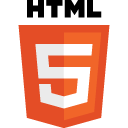 HyperText Markup Language (HTML) is the core language of nearly all Web content. Most of what you see on screen in your browser is described, fundamentally, using HTML. More precisely, HTML is the language that describes the structure and the semantic content of a Web document.
HyperText Markup Language (HTML) is the core language of nearly all Web content. Most of what you see on screen in your browser is described, fundamentally, using HTML. More precisely, HTML is the language that describes the structure and the semantic content of a Web document.
The articles listed below provide guides that will help you use HTML to its fullest potential.
- HTML forms guide
This guide is a series of articles that will help you master HTML forms.
- Introduction to HTML
This article provides an introduction to HTML. If you've ever wondered what goes on behind the scenes in your web browser, this article is the place to start learning.
- Using HTML5 audio and video
HTML5 introduces built-in media support via the
<audio>and<video>elements, offering the ability to easily embed media into HTML documents.
- Forms in HTML
- This article summarizes changes to HTML forms introduced in HTML5. For a detailed guide to using forms, see our extensive HTML forms guide.
- HTML5
- HTML5 is the latest evolution of the standard that defines HTML.
- Sections and Outlines of an HTML5 Document
- The HTML5 specification brings several new elements to web developers allowing them to describe the structure of a web document with standard semantics. This document describes these elements and how to use them to define the desired outline for any document.
- Using HTML5 audio and video
- HTML5 introduces built-in media support via the
<audio>and<video>elements, offering the ability to easily embed media into HTML documents. - Introduction to HTML
- This article provides an introduction to HTML. If you've ever wondered what goes on behind the scenes in your web browser, this article is the place to start learning.
- Content Editable
- Technical review completed.
- Content categories
- Each HTML element must abide by rules defining what kind of content it can have. These rules are grouped into content models common to several elements. Each HTML element belongs to zero, one, or multiple content models, each setting rules that the element's content must follow in an HTML-conformant document.
- Drag Operations
- The following describes the steps that occur during a drag and drop operation.
- Dragging and Dropping Multiple Items
- Mozilla supports the ability to drag multiple items using some additional non-standard methods. These are methods that mirror the
typesproperty as well as thegetData(),setData()andclearData()methods, however, they take an additional argument that specifies the index of the item to retrieve, modify or remove.
Overviews
Guides
- Email links
- It's often useful for Web sites to be able to create links or buttons that, when clicked, open a new outgoing email message. For example, this might be used when creating a "contact us" button. This is done using the
<a>element and themailtoURL scheme. - Event attributes
- Every HTML element has a set of attributes that allow for the execution of JavaScript when certain events happen. These attributes are called event attributes and are the name of the event prefixed by "on".
- HTML forms guide
- This guide is a series of articles that will help you master HTML forms.
- Obsolete practices to avoid
- This article tries to list older coding practices that over time have become unnecessary or bad practices.
- Recommended Drag Types
- HTML drag and drop supports dragging various types of data including plain text, URLs, HTML code, files etc. The document describes the best practices for dragging common data types.
- The Importance of Correct HTML Commenting
- When authoring HTML in standards mode, incorrectly formed comments can break your pages, resulting in part or all of your content being commented out. When authoring XHTML or XML, incorrect comments will result in your documents not being able to be displayed at all.
- Tips for authoring fast-loading HTML pages
- These tips are based upon common knowledge and experimentation.
- Using data attributes
- HTML5 is designed with extensibility in mind for data that should be associated with a particular element but need not have any defined meaning. data-* attributes allow us to store extra information on standard, semantic HTML elements without other hacks such as
classList, non-standard attributes, extra properties on DOM, or setUserData.
Sample code
Other pages
- Element
- An element is a part of a Web page or document. In XML and HTML, an element might contain a data item or a piece of a Web page such as a chunk of text or an image. A typical element includes an opening tag, attributes, content and a closing tag.
- Hyperlink
- Hyperlinks connect Web pages, or data items, to one another. In HTML, anchor elements define the hyperlinks you see when you browse the Web. An anchor can create a link from a part of a Web page, such as a text string or image, to another site, page or even a particular point within a page.
Join the Web layout community
- Stack Overflow: HTML topics